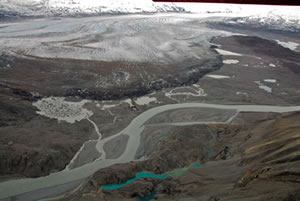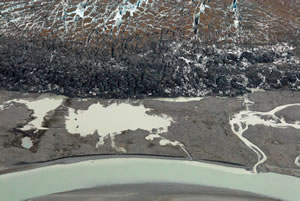Tweedsmuir Glacier surges toward the Alsek
Tweedsmuir Glacier surges toward the Alsek
Submitted by Ned Rozell
Phone: 907-474-7468
10/25/07


Download photos
A glacier is poised to dam the only river that cuts through a rugged 500-mile span of the St. Elias Mountains.
Tweedsmuir Glacier, born in the Yukon and following gravity’s pull through northern British Columbia, has surged to a point where it might pinch off the Alsek River, which flows into the Gulf of Alaska at Dry Bay.
Chris Larsen, a professor who studies glaciers and the uplift of the landscape resulting from glacial melt at the Geophysical Institute at the University of Alaska Fairbanks, flew over the glacier on Oct. 10, 2007. He saw that the Tweedsmuir was within 1,000 feet of reaching the Alsek River. Now, back at the institute, Larsen said Tweedsmuir is surging and advancing.
As part of a study of the region’s glaciers, Larsen and his colleagues first flew above Tweedsmuir Glacier to check its elevation in 2006. In one short year, things have changed.
"It was just a normal melting glacier back then," he said.
Bodies of ice like the Lowell Glacier, upstream of the Tweedsmuir, have stopped the river before. Scientists have found shorelines of a lake that formed behind the plug of surging Lowell Glacier. The lake, larger than Kluane Lake and with its shores reaching close to today’s town of Haines Junction, existed until the ice dam broke sometime in the mid-1800s, sweeping an entire village of Tutchone Natives into the sea at Dry Bay.
Tweedsmuir Glacier is advancing into the river at Turnback Canyon, a natural pinchpoint on the Alsek River that forces rafting groups to either portage for two days by walking over Tweedsmuir Glacier, or get a lift by helicopter. The current is so strong in the 15-mile gorge that biologists in 2003 noticed that migrating sockeye salmon advanced no farther than the downstream end.
Tweedsmuir’s advance toward the river is due to what glaciologists call a surge, which doesn’t mean the glacier has grown. Instead, the glacier suddenly spills forward at its tongue after years of snow and ice accumulates in its upper reaches. Cathy Conner and Daniel O’Haire explained surging glaciers in Roadside Geology of Alaska:
"A surging glacier advances at a hundred times its normal rate and then, overextended, dies in its tracks."
Many of these mysterious surging glaciers exist in Alaska, and the dynamic region near the Panhandle has more than 100 of them. Tweedsmuir last surged in the early 1970s and briefly blocked the river in midwinter before the river broke the dam. Surging glaciers often move forward in spring and summer then stop in fall, with an outburst of pent-up water. Scientists think glaciers surge when water pressure increases at their base, sometimes due to a clogged plumbing system, and the glacier becomes decoupled from its base of rocks and mud.
Tweedsmuir is interesting to scientists like Larsen because it seems to continue surging this fall, a time when rain or meltwater often triggers an outburst flood and grounds a surging glacier.
"If it (continues to surge) in the middle of winter, it could get itself in position to block the river," he said.
If the glacier blocked the river, the water would eventually eat through the ice-and-rock dam, and the real drama would begin.
"All the water would come out at once," Larsen said. "It wouldn’t be orderly."
This column is provided as a public service by the Geophysical Institute, University of Alaska Fairbanks, in cooperation with the UAF research community. Ned Rozell is a science writer at the institute. To view past columns or to subscribe, visit www.gi.alaska.edu/ScienceForum/index.html.


